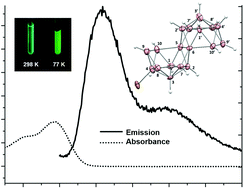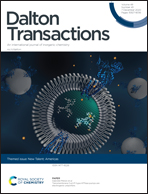A molecular boron cluster-based chromophore with dual emission†
Abstract
Bromination of the luminescent borane, anti-B18H22, via electrophilic substitution using AlCl3 and Br2, yields the monosubstituted derivative 4-Br-anti-B18H21 as an air-stable crystalline solid. In contrast to the unsubstituted parent compound, 4-Br-anti-B18H21 possesses dual emission upon excitation with UV light and exhibits fluorescence at 410 nm and phosphorescence at 503 nm, with Φtotal = 0.07 in oxygen-free cyclohexane. Increased oxygen content in cyclohexane solution quenches the phosphorescence signal. The fluorescent signal intensity remains unaffected by oxygen, suggesting that this molecule could be used as a ratiometric oxygen probe.

- This article is part of the themed collection: New Talent: Americas


 Please wait while we load your content...
Please wait while we load your content...